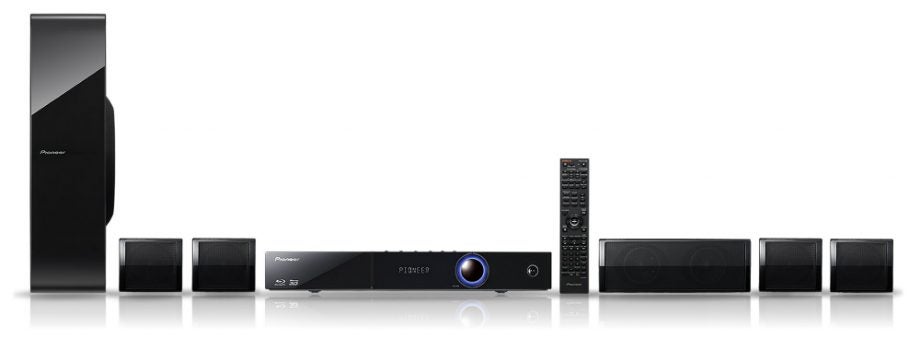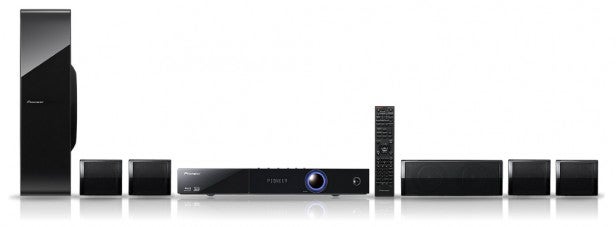Pioneer BCS-323 Review
Pioneer BCS-323
An affordable 5.1 surround sound system with decent features

Sections
- Page 1 Pioneer BCS-323 Review
- Page 2 Features and Operation Review
- Page 3 Performance and Verdict Review
Verdict
Pros
- Stylish, compact speakers
- Good feature list for the money
- Fills the room easily
Cons
- Soft, overly warm sound
- Limited internet content
- Remote
Key Specifications
- Review Price: £299.00
- 3D Blu-ray playback
- Compact satellite speakers
- DLNA file streaming
- Built-in Wi-Fi
- YouTube and Picasa
What is the Pioneer BCS-323?
It’s a 5.1-channel home cinema system that includes five compact satellite speakers, a slim subwoofer and a Blu-ray receiver. Basically, it provides everything you need in a single box, helping you avoid the hassle that comes with buying and installing separates. There are plenty of features on board too, including 3D, network functionality and an iPod dock.

Pioneer BCS-323 – Design
Inside the box are two smaller boxes, one containing the XV-BD121W Blu-ray receiver and another containing the S-BD121 speaker system. The four satellite speakers supplied for the front and rear channels are all identical – compact boxes measuring just 8cm high and 95mm wide. They’re the perfect size for placing discreetly on shelves or furniture without imposing on your living space.
Their design is appealing too, with a shiny gloss-black front panel framing the black speaker mesh, while the tapered back end has a plasticky matt finish. While we’d hardly describe them as luxurious, their robust build quality is decent for the money. Unusually the speaker cables are permanently attached and not connected to springclips, which means you’ll need a whole new speaker if you accidentally cut the cable or break the plug.
The centre speaker is about twice as wide as the other satellites, which makes it more suitable for placement in front of your TV or on an AV stand. It’s styled in exactly the same manner as the rears, with a combination of gloss and matt black plastic.
The biggest difference between budget all-in-one systems like this and separates systems is the subwoofer. One-box systems usually come with a passive sub, which means they don’t have their own power supply or amplifier – they simply respond to the amplified signal from the receiver.
Active (powered) subs typically provide a more potent, controlled performance – as well as giving you more control over how they sound – but they’re more expensive. Passive subs allow manufacturers to cut costs and reach an attractive price tag.
So inevitably the BCS-323 comes with a passive sub, with a lightweight cabinet that sounds worryingly hollow when you tap on the side. It looks nice though, with a glossy front panel and silky cloth covering the side driver, plus its narrow width makes it easy to slide into tight spaces.
The Blu-ray receiver is chunky but looks gorgeous, styled with Pioneer’s customary sleekness. The gloss black fascia looks nice and shiny, dominated by a large volume dial that’s surrounded by a ring of purplish light. On the right hand side is a flap hiding two USB ports and two 3.5mm audio inputs – one for portable devices and one for a microphone (yes, there’s a karaoke feature).
On top, along the front edge you’ll find a few buttons for up-close control. Its top panel is fashioned from aluminium, giving the unit a firm and solid feel. The fascia is plasticky, but that’s par for the course at this price.
Pioneer BCS-323 – Connections
Inspecting the rear panel, we find a generous selection of sockets. Alongside the ARC-compatible HDMI v1.4 output you’ll find two HDMI inputs, allowing you to enjoy other HD sources through the Pioneer’s speakers – as well as using it as a switcher.

There are two optical digital audio inputs, analogue stereo input, a composite video output, Ethernet and FM antenna input. The speaker cables are connected using chunky colour-coded plugs.
The supplied iPod dock can be connected to a port on the back, although its older 30-pin connection means it won’t support iPhone 5 or iPod Nano 7G without an adapter. Optional Bluetooth adapters, AS-BT100 or AS-BT200, can be connected to the port on the back, allowing you to stream music wirelessly from phones and laptops.

